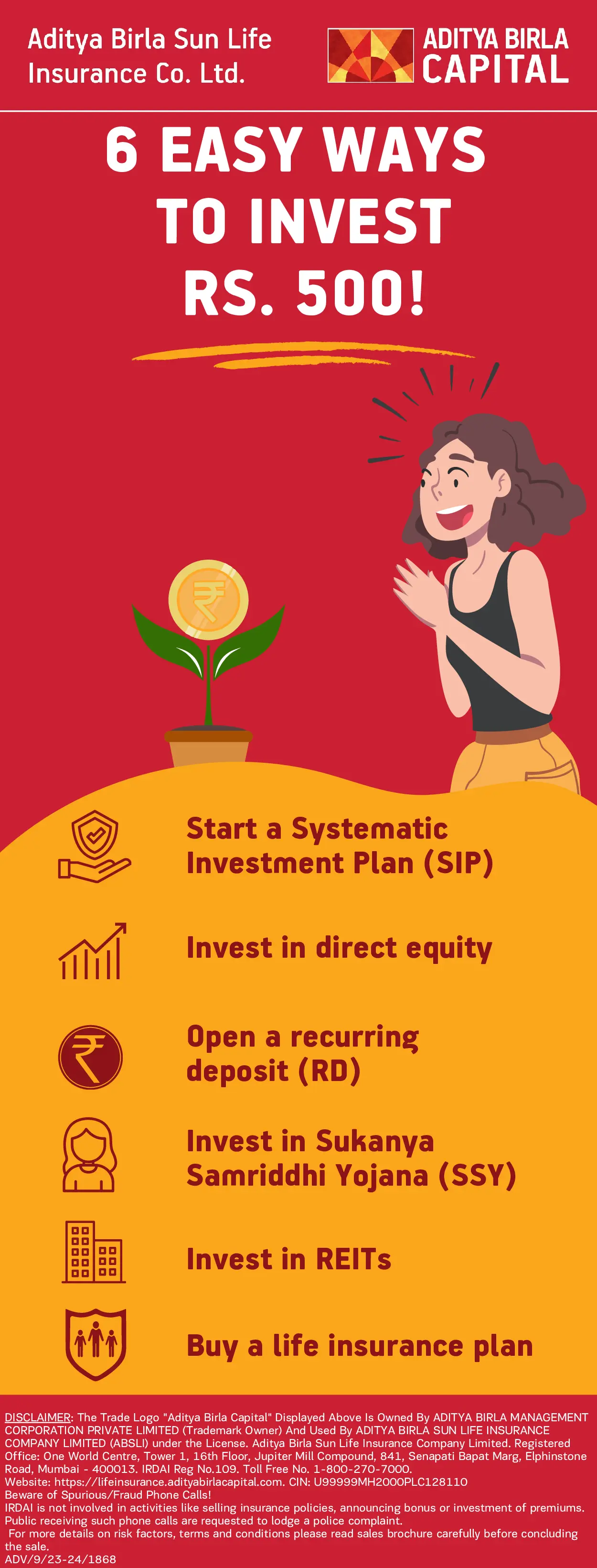Aditya Birla Sun Life Insurance Company Limited
How To Invest 500 Rupees Per Month?

Plan Smarter, Live Better!

Thank you for your details. We will reach out to you shortly.

Currently we are facing some issue. Please try after sometime.
Read Aloud


- Table of Contents
It's widely advised that starting your investment journey earlier in life can be extremely rewarding. And yet, there are many reasons why people may put off investing for a later time.
Like a lack of adequate financial Or a fear of getting started. Or even an overload of choices.
All of these can hold people back and make them delay investing their money. In addition to these factors, there's another common reason that deters people from taking that leap and making an investment.
Wondering what that is? It's quite simple, really. Not having a lump sum amount ready is one of the biggest roadblocks that stop people from investing. Interestingly, you don't need a huge chunk of money to get started. It's quite possible to invest even smaller amounts. Even an amount as little as Rs. 500 can go a long way over the years.
So, if you've also been putting off investing because you don't think you have enough to get started, don't you worry. All you need is Rs. 500.
Here's what you can do with this seemingly small amount today, so you can turn it into a bigger amount over the years.
Start a Systematic Investment Plan (SIP)
You can invest just around Rs. 500 each month in mutual funds through a Systematic Investment Plan (SIP). Over the long term, these small amounts will continue to add up and grow into a large corpus. SIPs give you many other advantages too, such as the following.
- An early start:
You get to start investing much earlier in life, since you don't have to wait around for a lump sum amount. - Rupee cost averaging:
When prices are lower, you buy more units of mutual funds. And when they are higher, you buy fewer units. This eventually brings down the long-term cost of investment. - Disciplined savings:
SIPs help you save in a disciplined and consistent manner. This in turn allows you to create more wealth over time.
Here's an example to show you how a monthly SIP of just Rs. 500 can grow over the long term.
| Particulars of your SIP | Details |
| Monthly investment | Rs. 500 |
| Investment period | 20 years |
| Total investment | Rs. 1,20,000 (Rs. 500 x 12 months x 20 years) |
| Expected rate of return | 10% per annum |
| Investment value at the end of 20 years | Rs. 3,82,848 |
| Total returns earned | Rs. 2,62,848 (Rs. 3,82,848 - Rs. 1,20,000) |
See how merely investing Rs. 500 each month can more than double your total investment? The key here is consistency and disciplined investing. It also helps if you invest according to your risk appetite. For instance, when you are younger and can take on more investment risk, you could choose equity funds that may deliver higher returns. With time, you could make the transition to debt funds.
Invest in direct equity
Rs. 500 may be a small amount. But it is not too small to buy some direct equity. This is, of course, a viable option if you are a risk-aggressive investor. But even if you are not, investing just Rs. 500 in direct equity won't really be much of a risk.
However, can this kind of an investment really turn into thousands or lakhs over the years? Well, that depends on many factors. But to truly ensure that you make the most of your Rs. 500 when you invest in direct equity, here's what you need to do.
- Choose growth stocks
Growth stocks are essentially stocks that are expected to grow at a much higher rate than the industry average. So, while the average equity returns may be around 13% to 15%, there are instances where growth stocks have delivered MUCH higher gains - in the range of 50% to 500% or higher. In rare cases, the returns from growth stocks have even touched 1,000% to 2,000% or more! - Stay invested for the long term
Growth does not happen overnight - particularly sustained growth. So, it pays to be patient, quite literally. If you remain invested for the long term, the chances of the share price increasing also go higher. Plus, it has always been an open secret that equity investments deliver better returns the longer you stay invested in the stock.
Open a recurring deposit (RD) account
If high-risk investments are not for you, the recurring deposits are your new best friend. You can simply open an RD account with a bank or a post office, and start investing Rs. 500 each month. The amount you invest will continue to earn interest over the period of investment.
Let's take a quick look at an example of how a recurring deposit will grow with time.
| Particulars of your RD | Details |
| Monthly investment | Rs. 500 |
| Investment period | 5 years |
| Total investment | Rs. 30,000 (Rs. 500 x 12 months x 5 years) |
| Expected rate of return | 5.5% per annum |
| Investment value at the end of 5 years | Rs. 34,575 |
| Total returns earned | Rs. 4,575 (Rs. 34,575 - Rs. 30,000) |
These returns may be more modest when compared with other options like equity and mutual funds, but RDs help you preserve your capital. If your number one goal is to keep your money safe, then RDs may be ideal for you, since they do that, and simultaneously help you earn some extra money on your investment.
Save up for your daughter's future with Sukanya Samriddhi Yojana
Sukanya Samriddhi Yojaja (SSY) is a government-backed scheme that was launched specifically to help parents save up for the future of girl children. So, if you have a daughter, you too can make use of this scheme to ensure that her future is financially secure.
Here are the key things you should know about the SSY scheme.
- Only one SSY account is permitted for each girl child.
- A parent can only create two SSY accounts in total.
- However, in case a parent has one daughter followed by twin girls, they can open three SSY accounts.
- You only need Rs. 250 to open an SSY account.
- Also, you only need an annual investment of Rs. 250 to keep your account active.
- The maximum amount you can invest each year is Rs. 1.5 lakhs.
- The maturity period of an SSY account is 21 years.
- But you only have to make deposits for 15 years.
Let's look at how your money will grow if you open an SSY account and deposit RS. 500 each month.
| Particulars of your SSY investment | Details |
| Monthly investment | Rs. 500 |
| Start year | 2021 |
| Maturity year | 2042 |
| Investment upto year | 2036 |
| Investment period | 15 years |
| Total investment | Rs. 90,000 (Rs. 500 x 12 months x 15 years) |
| Current rate of return (as of 2021) | 7.6% per annum |
| Maturity value at the end of 21 years | Rs. 2,54,606 |
| Total returns earned | Rs. 1,64,606 (Rs. 2,54,606 - Rs. 90,000) |
Invest in real estate through REITs
With only Rs. 500 in hand, it may be natural to sidestep real estate as an option. After all, investing in property is a costly affair, right? Well, not quite. Real Estate Investment Trusts (REITs) make it possible for you to invest in real estate with a much smaller amount.
What are REITs?
REITs are companies that own a portfolio of high-end real estate properties like business units, residential properties that are leased out or rented out, hotels, medical facilities and retail spaces. Now, if you want to invest in these kinds of properties directly, you know it's going to take a huge amount of capital. But by buying the shares of a REIT, you can indirectly invest in those high-end real estate assets and benefit from higher returns. Simple, right?
How much can you invest in REITs?
Earlier, the minimum application amount for investing in REITs was capped at Rs. 50,000! But recently, SEBI stepped in and brought this down to Rs. 10,000. This was done with a view to increase the participation of retail investors in the REIT investment space.
The earlier limit was too daunting for regular investors. But now, you can easily save up Rs. 500 each month for a while, and invest that amount in REITs. SEBI has also revised the trading lot to one unit. So, you can even trade in REITs just like you would trade stocks.
Buy a life insurance plan
All of these investments that you make and assets that you buy - they are all primarily needed so you can financially protect your family, isn't it? After all, every provider worries about how their family would meet their goals and pay for their expenses in case something untoward happens.
But did you know that with as little as Rs. 500 per month, you can actually secure the financial future of your family? Yes, you read that right. With an amount in this range, you can buy a life cover in the form of a term insurance plan. Being the most affordable kind of life insurance, term plans are easy on the pocket, and offer high death benefits in return.
For instance, the ABSLI DigiShield Plan is a comprehensive term insurance policy that gives you a life cover of Rs. 1 crore at just Rs. 477 per month.* You can also choose to invest in a savings plan or a ULIP1, although those plans would come with higher premiums.
*Scenario: Female policyholder, aged 21 years, buying a level term insurance, with regular premium paying term, and a policy term of 25 years (excl GST)

Thanks for reaching out. We will reach out to you shortly.
Thanks for reaching out. Currently we are facing some issue.
Get immediate income payout after 1 day of policy issuance^
ABSLI Nishchit Aayush Plan
Guaranteed# Income
Life Cover across policy term
Lumpsum Benefit at policy maturity.
Get:
₹33.74 lakhs~
Pay:
₹10K/month for 10 years
Most Popular Calculator
Guaranteed returns after a month¹
1Tax benefits are subject to changes in tax laws. Kindly consult your financial advisor for more details.
ADV/8/21-22/929







